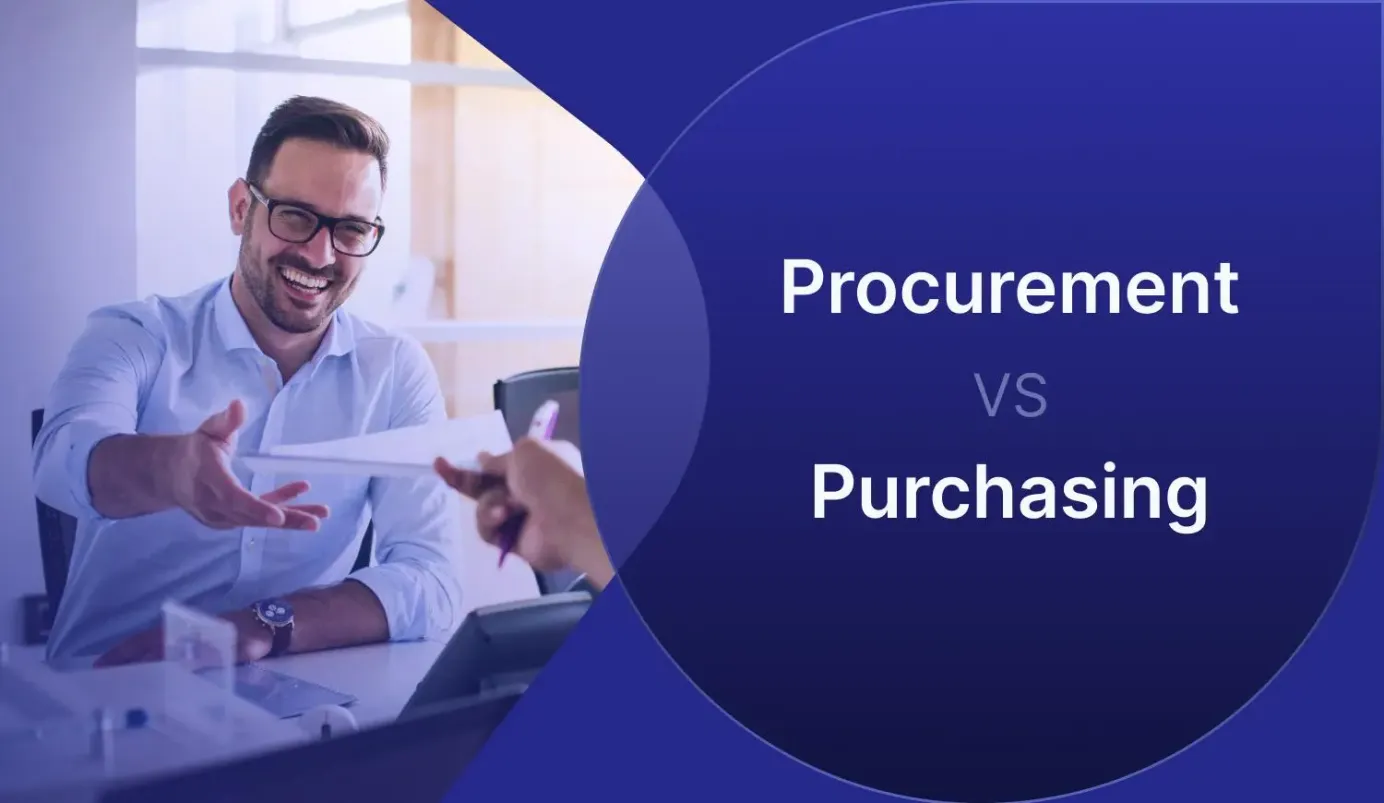
17 min read
Procurement vs. Purchasing: Similar but Different
Detailed side-by-side comparison of procurement vs. purchasing. Learn why they aren’t the same and how the difference impacts your business.
What do you call it when you order, say, stationery for your office? Is it procurement or purchasing? Many use these terms interchangeably, but procurement and purchasing are distinct yet closely linked functions.
In this article, we’ll break down the differences between purchasing versus procurement and explore how they both contribute to the success of your business. With this in mind, you can fine-tune each process to deliver specific benefits for your company.
Keep reading to learn:
Procurement vs. Purchasing at a Glance
What is Procurement?
What is Purchasing?
Procurement vs. Purchasing: Key Differences Explained
Why the Distinction Between Purchasing vs. Procurement Is Important
How to Improve Your Procurement and Purchasing Processes
Procurement vs. Purchasing at a Glance
Procurement is a complex, strategic process that involves sourcing, buying, supplier management, contract negotiation, and long-term planning. As a proactive function, procurement helps companies meet their internal needs and gain a competitive advantage.
In contrast, purchasing is a more straightforward and reactive process. It involves placing orders, managing deliveries, and processing payments. Purchasing has fewer steps and is more transactional, focusing on price rather than the overall value of the item.
Here’s the table of key distinctions between procurement vs. purchasing.
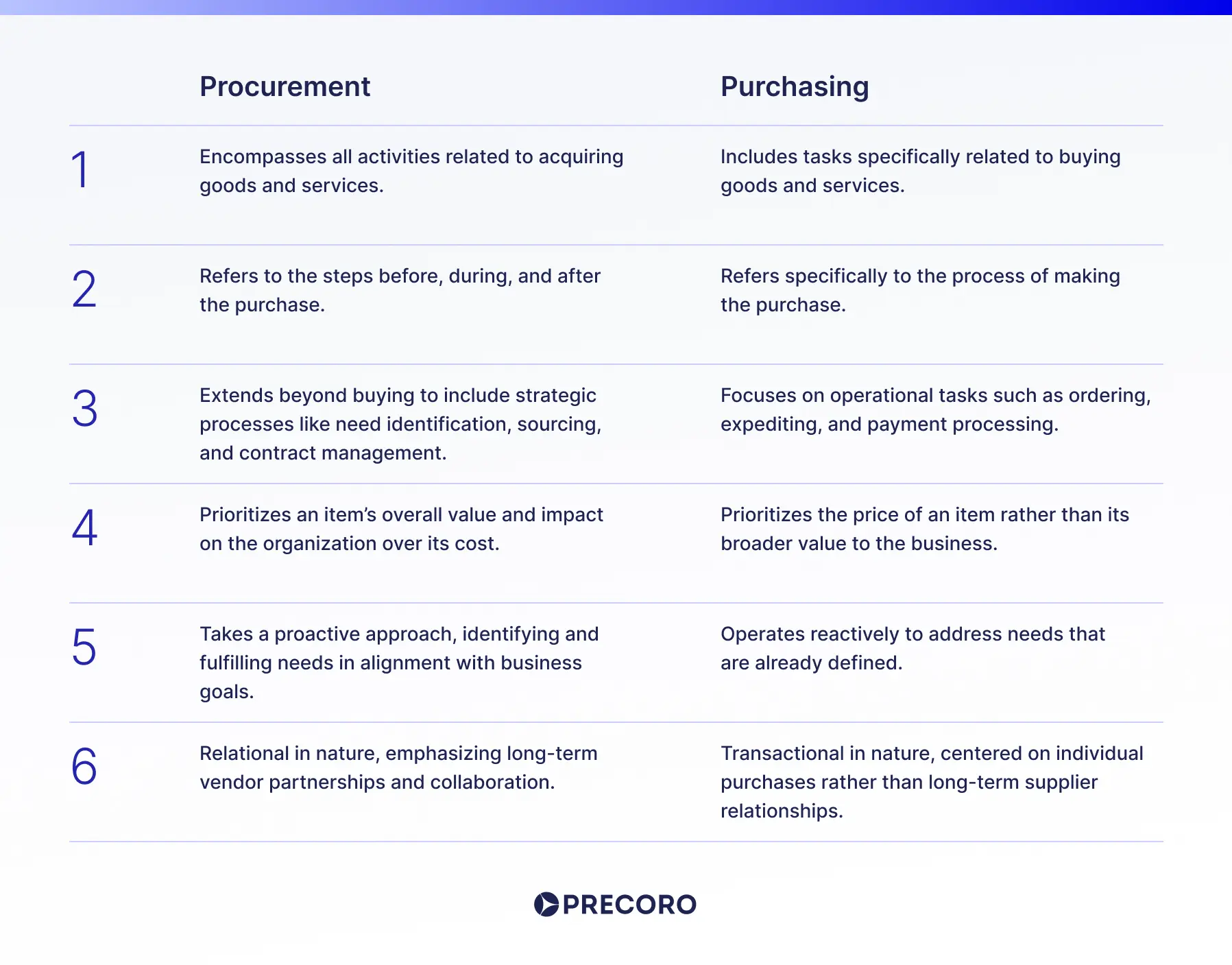
Before we explore the in-depth differences between procurement vs. purchasing, let’s first examine what each process involves.
What is Procurement?
Procurement is the end-to-end process of acquiring goods and services that a business needs to operate effectively. It’s more than just buying things — it’s about planning, evaluating options, and ensuring each purchase brings value to the company.
The procurement steps (also known as the procure-to-pay cycle) can vary depending on the business’s size and industry, but typically include:
- Identifying Internal Needs
The first step in procurement is determining what goods and services the organization needs. It involves assessing current operations and analyzing historical data. This step also requires cross-department collaboration to find gaps and accurately forecast needs for upcoming projects.
The most straightforward way to capture these needs — is to set up a process for employees to create purchase requisitions (PRs) whenever they require products or services. After specifying the items and quantities needed, employees submit the PRs for approval from relevant authorities, such as department managers, finance teams, procurement managers, or senior executives.
- Researching the Market and Shortlisting Suppliers
Once the organization’s needs are clear, procurement specialists can either select from existing suppliers or search for new vendors. The goal is to find those better suited to the company’s evolving demands.
To find a new supplier, the procurement team explores a wide range of options through industry databases, online marketplaces, professional events like trade shows, and recommendations from industry peers. After identifying relevant suppliers, procurement specialists narrow the list to those that best align with the organization’s requirements, preparing for a more detailed evaluation process.
- Issuing an RFQ or RFP and Selecting the Supplier
To assess potential suppliers, the procurement team typically issues a Request for Quote (RFQ) or a Request for Proposal (RFP). An RFQ is used when the buyer has a clear idea of the product or service needed and mainly compares prices. On the other hand, an RFP is used to also evaluate additional factors such as quality, delivery schedules, innovative solutions, and service terms, especially for large projects.
After receiving quotations or proposals from vendors, procurement specialists compare them to select the best one. Ideally, the chosen supplier should provide a balance of cost, quality, and dependability to support the business effectively.
- Negotiating Terms and Signing the Contract
Negotiating terms is a key step in which the procurement team works with suppliers to agree on important details like pricing, delivery schedules, payment terms, and warranties. This process can take anywhere from a few days to several weeks, depending on the complexity of the agreement and the number of parties involved.
Negotiations often start with the procurement team sending the supplier a clear outline of their requirements, including expectations for pricing, delivery, and other key terms. From there, the supplier responds with their offer, and both sides engage in discussions to refine and adjust the details. Procurement teams may use leverage such as order volume, long-term business potential, or competitor offers to negotiate better terms.
A key to smooth negotiations is preparation — knowing exactly what the company needs, understanding the supplier’s position, and being open to compromise where necessary. Once both sides agree on the terms, the final step is to sign the procurement contract.
- Creating and Approving a Purchase Order
A purchase order (PO) is a legal document that outlines the details of a purchase, including quantity, price, payment terms, and delivery schedules. If the company has a purchase requisition process, the approved PR is converted into a PO after the contract is signed.
If there’s no PR process, the procurement manager creates the PO from scratch, outlining the necessary details. The PO may also require approval before being sent to the supplier to ensure it aligns with company policies on spending and procurement.
The supplier reviews the purchase order, confirms they can fulfill it, and sends confirmation back. Once confirmed, the PO becomes legally binding, and the supplier proceeds to fulfill the order as agreed.
- Receiving and Inspecting Delivered Items
When the order arrives, the receiving team verifies that the correct quantity and type of items have been delivered, checking for any visible damage or defects. If there are any discrepancies, like missing or damaged items, the procurement team steps in to work with the supplier to resolve the issue.
Once the products pass the quality check, the receiving team, often the warehouse team, generates the goods receipt, which is logged into the system. This officially records the items as received.
- Processing an Invoice and Making a Payment
The accounts payable team reviews the invoice sent by the supplier, ensuring it reflects the correct price, quantity, and other terms, such as taxes or shipping costs. They check that the invoice matches the approved goods receipt and purchase order to confirm the details in the process called three-way matching.
Once the invoice is validated, the accounts payable team issues a payment to the supplier. This typically follows the agreed-upon payment terms outlined in the contract (typically net 30 days or net 60 days).
- Record-Keeping
Record-keeping is about staying organized and making sure everything related to purchases is documented properly. This includes keeping track of purchase orders, invoices, contracts, and receipts. Having everything in order helps prevent overspending, ensures you’re following company rules, and makes audits easier.
Proper record-keeping also comes in handy if there are any issues with suppliers, as you can quickly refer back to the original documents. Plus, by keeping a history of your purchases, you can evaluate suppliers and make better decisions for future purchases.
- Evaluating the Supplier and Building Strong Supplier Relationships
Supplier evaluation typically involves reviewing key performance indicators (KPIs) such as delivery times, product quality, and pricing accuracy. The procurement manager also looks at factors like profit margins and contract compliance to determine whether the supplier met expectations.

This assessment helps in understanding if the supplier is reliable and provides value to the business. If the supplier has performed well, the procurement manager may decide to continue the relationship and possibly negotiate for better terms in future transactions. On the other hand, if performance was lacking — whether in product quality, delivery consistency, or customer service — the manager may explore other suppliers for future needs.
Building a strong supplier relationship means creating mutual benefits over time by fostering positive, long-term partnerships with suppliers who reliably meet the company’s needs. This process involves open and transparent communication, collaborating on forecasts, joint problem-solving, and timely payments.
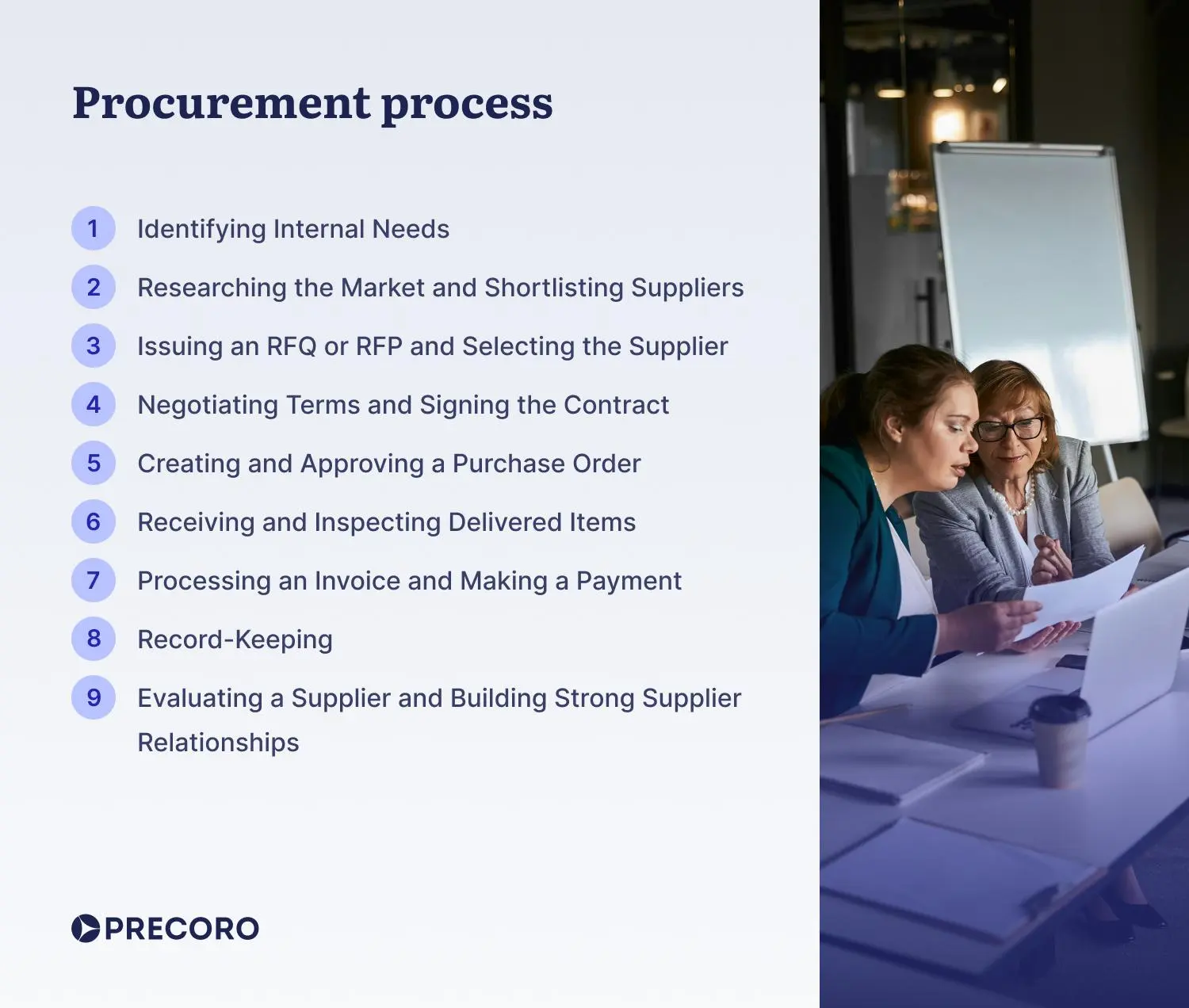
What is Purchasing?
Purchasing is the hands-on, transactional aspect of acquiring items that a business needs. This process typically involves handling routine, well-defined purchases and focuses precisely on buying — placing orders, processing payments, and ensuring goods or services are delivered as agreed.
The purchasing process usually includes:
- Creating a Purchase Requisition (PR)
The purchasing process begins when a department or an individual submits a purchase requisition with details of the needed item, quantity, and desired delivery date. This document provides the initial information needed to begin the purchasing process and helps to prevent errors or misunderstandings regarding the employee request.
- Approving the PR
The approval process ensures that the expense is justified, within the organization’s budget, and complies with company policies, such as procurement guidelines or spending limits. That’s why an employee may need approval from relevant authorities, such as department heads, the finance manager, the procurement manager, or C-level executives.
- Issuing a Purchase Order
Once the purchase requisition is approved, the purchasing team generates and sends a purchase order (PO) outlining items, quantities, agreed prices, and delivery terms. In some companies, however, the purchasing process may begin directly with the purchase order, skipping the requisition step.
- Receiving the Order
When the ordered items are delivered, the receiving team checks the order against the purchase order. This step includes verifying that the right quantities have been delivered, inspecting the items for any defects or damage, and ensuring they meet the agreed-upon specifications and quality standards.
- Verifying the Invoice and Performing a 3-Way Match
After the goods or services are received and verified, the supplier sends an invoice. The accounts payable team performs a three-way match, comparing the invoice with the purchase order and the receiving documentation. This ensures that the quantities, prices, and any agreed-upon terms, such as discounts or additional charges, are consistent across all documents. If everything matches, the invoice is approved for payment.
If any discrepancies arise, such as incorrect pricing or missing items, the invoice may be sent back for clarification or adjustment. In some cases, to ensure proper validation and authorization of payment, invoices may require additional approvals from department heads or finance managers. This step helps prevent errors and ensures financial accuracy.
- Making a Payment
The accounts payable team checks that the payment terms, such as discounts or penalties, are met. Then, the appropriate payment method (for example, wire transfer, credit card, or check) is used to pay the supplier. After payment, the transaction is recorded in the company’s financial system, and the supplier is notified.
When you look at the actual steps in the procurement vs. purchasing processes, it’s clear that the latter is part of the former.
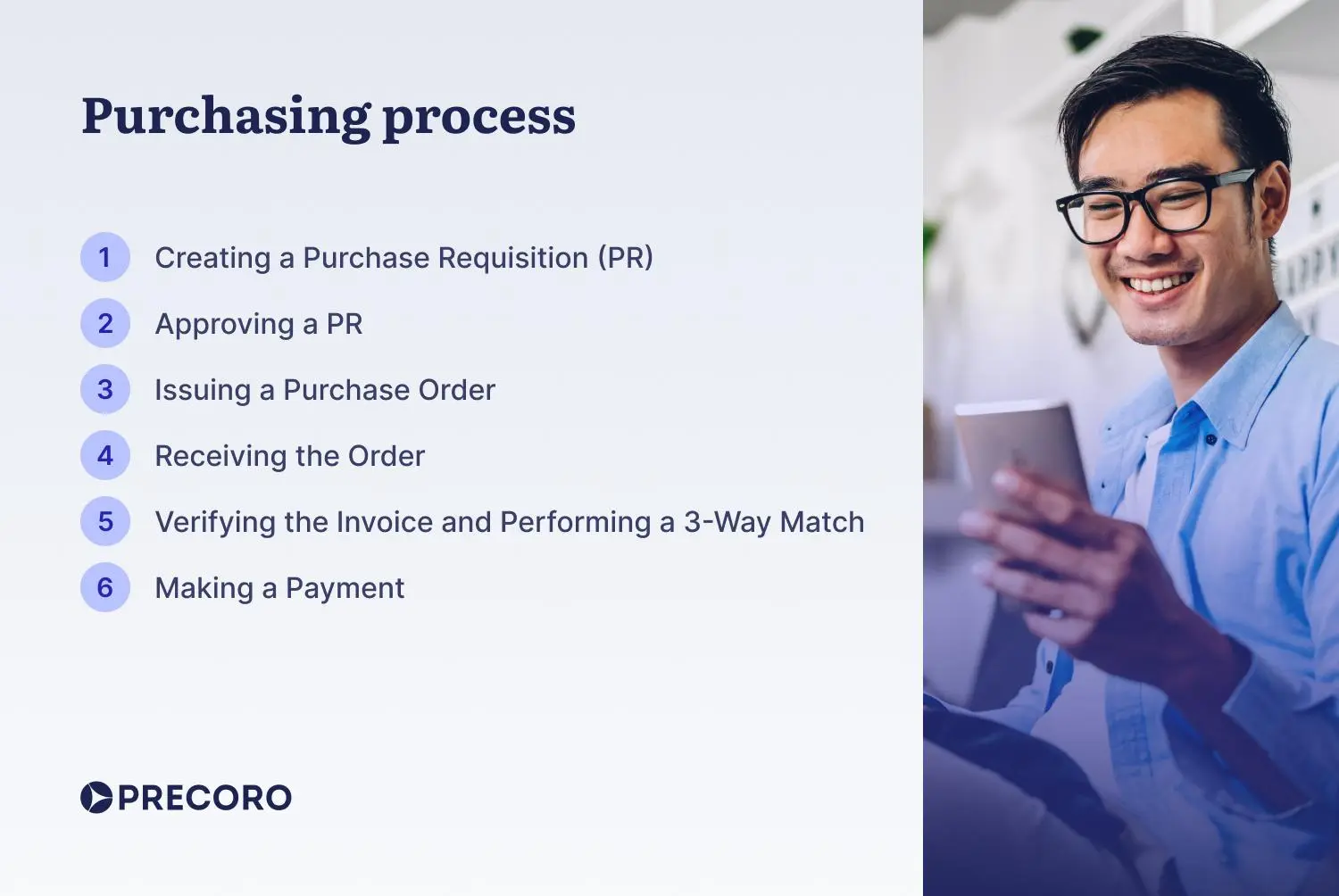
Procurement vs. Purchasing: Key Differences Explained
As you can see, both purchasing and procurement processes are related to acquiring goods and services a business needs. However, they play different roles in how companies manage spending. Let’s break down the key differences between procurement vs. purchasing:
Scope: Big Picture vs. Day-to-Day Operations
Procurement and purchasing reveal clear differences in scope and complexity. Procurement is the big picture — it’s a strategic process that involves planning, sourcing, negotiating, purchasing, and managing supplier relationships and contracts. It’s all about making smart, long-term decisions to support the company’s goals.
Purchasing, on the other hand, focuses on day-to-day transactions, taking a more tactical approach than strategic. It involves executing orders, processing payments, and ensuring goods or services are delivered as expected. As a result, purchasing managers focus more on the cost of items.
Main Goal: Value Creation vs. Order Fulfillment
When exploring procurement vs. purchasing, it’s clear that both processes have different objectives. The goal of procurement is to create long-term value. This includes reducing costs, building strong supplier partnerships, managing risks, and finding innovative solutions to meet the company’s needs.
In fact, now is the moment for procurement leaders to embrace a new era of value creation. According to McKinsey, the role of Chief Procurement Officers (CPOs) has evolved beyond merely safeguarding a portion of enterprise costs. Today, more than ever, they can become strategic partners to CEOs, CFOs, and COOs, driving value and influencing key business decisions.
Purchasing, however, is all about buying goods and services efficiently. Its primary goal is to ensure the right items are ordered, delivered on time, and paid for without errors. Therefore, purchasing operates within the parameters set by procurement.
Complexity: Intricate Process vs. Straightforward Workflow
The difference between procurement vs. purchasing becomes evident when comparing their complexity. Procurement is a multi-step process that requires strategic thinking, thorough planning, and collaboration across departments. That’s why it’s a more complex process, which involves more people and requires additional resources.
Purchasing, on the other hand, is only a part of a broader procurement process, which is focused on placing orders. As a result, the purchasing process engages fewer people, making it less bureaucratic and time-consuming.
Focus: Relationships vs. Transactions
The focus of procurement vs. purchasing reveals another important differentiator. Procurement emphasizes building and maintaining strong relationships with suppliers. It’s about working together to achieve mutual benefits, like better pricing, quality improvements, or sustainable practices.
Purchasing is more transactional and less relationship-driven. It’s about completing specific orders with the existing supplier base under agreed-upon terms.
Approach: Proactive vs. Reactive
Another key area where procurement and purchasing differ is their approach. Procurement is proactive and forward-thinking. The procurement team anticipates the organization’s needs, strategically plans for sourcing the necessary goods or services, and negotiates long-term contracts. Thus, procurement isn’t just about addressing immediate requirements but also about mitigating risks, optimizing costs, and aligning with business objectives in the long run.
Purchasing, on the other hand, operates reactively. It steps in once a specific need has already been identified, focusing on executing orders to fulfill it. Purchasing agents act quickly and efficiently to address immediate demands, often based on terms and suppliers already established by procurement.
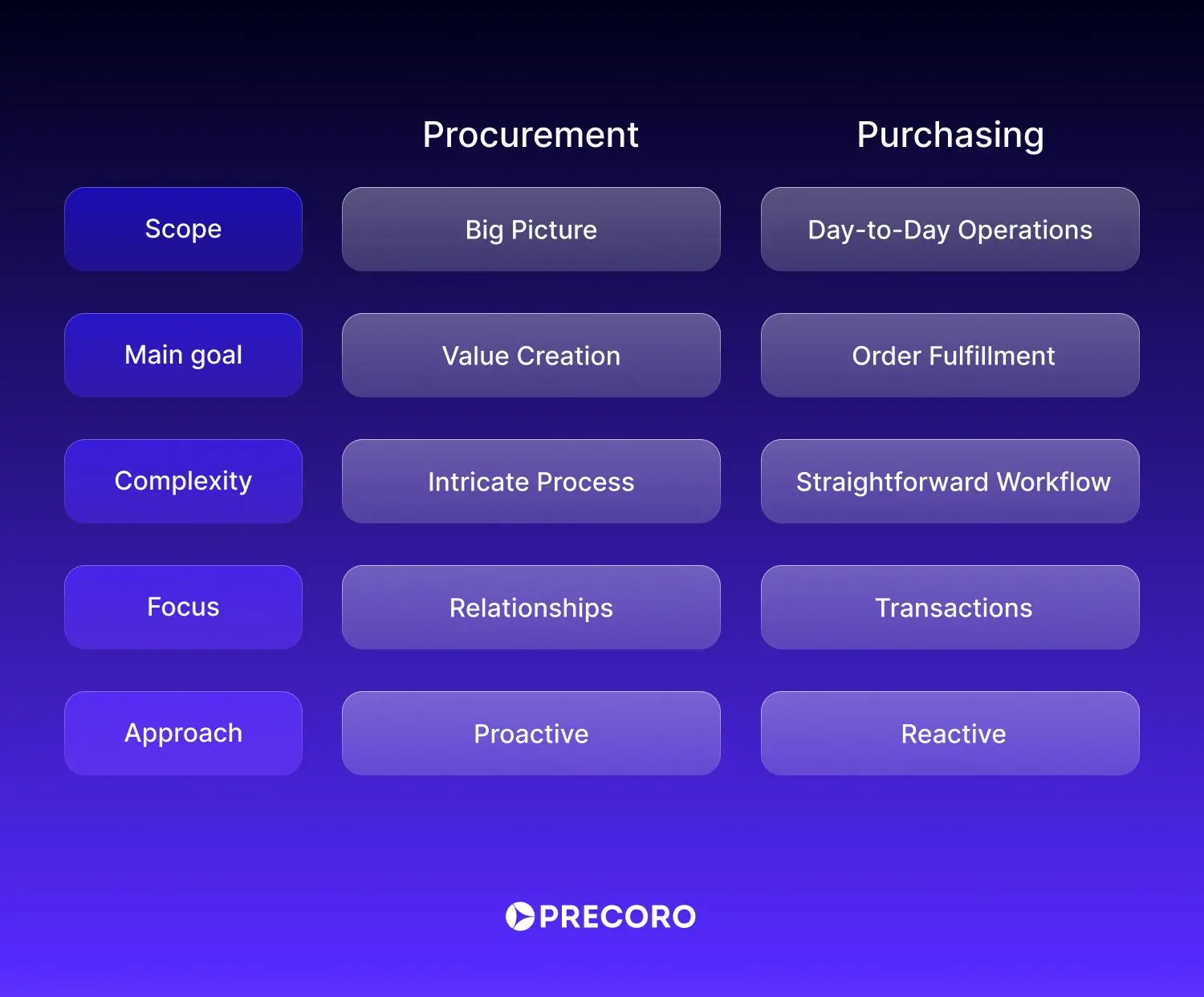
Why the Distinction Between Purchasing vs. Procurement Is Important
Understanding the differences between procurement vs. purchasing is essential for businesses aiming to save money, improve efficiency, and stay competitive. Here’s why it matters:
Avoiding Missed Opportunities
When businesses blur the lines in the purchasing vs. procurement distinction, they often focus only on meeting short-term needs, missing out on the broader strategic advantages procurement offers. These benefits include optimizing supply chains, minimizing risks, and reducing costs.
For example, procurement teams can analyze spending patterns to identify trends and consolidate purchases, which may qualify their companies for volume discounts and better contract terms. Procurement managers can also explore emerging suppliers offering innovative solutions that improve quality or reduce costs over time.
Streamlined Operations
By clearly separating procurement vs. purchasing, businesses can ensure that each function operates at its highest potential. Moreover, this approach ensures clear accountability — procurement managers are accountable for securing the best suppliers and terms, while purchasing agents are responsible for the smooth execution of those agreements. This division minimizes confusion, optimizes resource allocation, and leads to faster, more accurate order fulfillment.
Cost Savings Beyond Price Tags
By recognizing the distinction between purchasing vs. procurement, businesses can avoid the trap of focusing solely on price and make more informed decisions that save money in the long run.
Purchasing typically focuses on the upfront price of a product or service — how much it costs right now and whether it fits within the budget. However, procurement goes further and considers the total cost of ownership (TCO). TCO is a complete assessment of all costs tied to a product or service, such as delivery fees, installation costs, maintenance, training, repair, and potential disposal or replacement costs.
By taking these factors into account, procurement managers can identify cost-effective solutions that offer better long-term value, even if their upfront cost is higher. For example, a slightly more expensive product may have lower maintenance costs or offer a longer lifespan, ultimately reducing the total cost over time.
Improved Risk Management
By understanding the distinction between procurement vs. purchasing, businesses can rely on procurement to mitigate risks before they become costly problems, including factors like:
- Supplier disruptions (like delays, bankruptcies, or geopolitical instability)
- Price volatility (like fluctuations in raw material costs or changes in currency exchange rates)
- Compliance issues (like regulatory changes or failure to meet environmental standards)
By considering these risks upfront, procurement teams can devise strategies to mitigate them — whether that means securing backup suppliers, locking in prices through long-term contracts, or ensuring compliance with international regulations.
Driving Innovation and Sustainability
If a company treats procurement and purchasing as the same, it risks focusing solely on the transactional aspects of purchasing. While this approach has its place, strategic procurement goes further — it drives innovation and fosters sustainability by partnering with forward-thinking suppliers.
Such suppliers can not only deliver high-quality products but also provide solutions that align with long-term sustainability goals. These include sourcing eco-friendly materials, adopting energy-efficient technologies, and collaborating with vendors committed to strong corporate social responsibility (CSR) practices.
How to Improve Your Procurement and Purchasing Processes
When you’re navigating the nuances of procurement vs. purchasing, there are always opportunities to streamline your processes, improve efficiency, and reduce costs. Here are some actionable steps to level up both functions:
Standardize Your Processes
Well-defined workflows ensure that both purchasing and procurement processes are predictable, efficient, and error-free. They help teams work cohesively, improve compliance, and build a foundation for scalability as the organization grows.
Clearly outline and document the steps in purchasing and procurement processes so team members know exactly what to do and when, minimizing the need for ongoing guidance. For procurement, this might include defining how to evaluate suppliers, manage negotiations, and draft contracts. For purchasing, it could outline tasks like placing orders, tracking deliveries, and processing payments.
Then, standardize templates for documents like contracts, purchase requisitions, and purchase orders. These templates ensure that all necessary information is included, from payment terms to delivery conditions, leaving no room for misinterpretation. Consistency also simplifies training new team members, enhances collaboration across departments, and facilitates compliance with company policies or legal requirements.
Last but not least, establishing clear approval hierarchies is crucial for maintaining control over spending. For procurement, this might involve requiring senior management approval for high-value contracts or vendor agreements. For purchasing, it could mean ensuring department heads review purchase requisitions. By defining who needs to sign off on each step, organizations can streamline decision-making and ensure accountability, especially for high-stakes purchases.
Collaborate Across Departments
Procurement and purchasing don’t exist in a vacuum. Effective collaboration with other departments ensures smooth operations and better decision-making, but it doesn’t have to mean endless meetings or shared KPIs. The key is to establish clear communication frameworks and well-defined roles that enable alignment without overwhelming anyone.
Outline clear responsibilities to avoid overlap between procurement vs. purchasing. Purchasing agents should focus on executing orders and managing short-term buying needs, while procurement managers handle long-term supplier relationships, strategic sourcing, and risk management. At the same time, finance should focus on budget approval and cash flow management, and operations can outline logistical needs. Knowing who does what prevents bottlenecks and confusion.
Having a feedback loop between teams is also highly beneficial. Procurement can collaborate with operations to evaluate supplier performance and delivery quality, while finance can guide procurement on budget constraints and cost-saving opportunities. This information exchange fosters better strategies and minimizes reactive decision-making.
Track Key Metrics
Measure what matters for procurement vs. purchasing. Metrics show how well each function is performing and highlight areas for improvement.
Key procurement metrics:
- Cost Savings
Track the savings achieved through strategic negotiations, volume discounts, or competitive sourcing. This metric demonstrates how procurement contributes to the company’s bottom line.
- Supplier Performance
Evaluate suppliers based on reliability, quality, and delivery consistency. Key indicators include on-time delivery rates, defect rates, and responsiveness to issues.
- Contract Compliance
Monitor adherence to the terms outlined in procurement contracts to ensure suppliers meet agreed-upon standards and pricing. Non-compliance can lead to unexpected costs, delays, or quality issues.
Key purchasing metrics:
- Order Accuracy
Measure the percentage of orders delivered correctly, matching the purchase order in terms of quantity, specifications, and condition. High order accuracy reduces the need for returns and additional follow-up.
- Delivery Timelines
Track how often deliveries arrive on or before the agreed deadlines. Late deliveries can easily disrupt operations and increase costs, so this is a critical metric for evaluating purchasing efficiency.
- Invoice Matching Accuracy
Assess how frequently invoices match purchase orders and delivery receipts. Errors in matching result in delayed payments, damaged supplier relationships, and administrative bottlenecks.
Adopt a Platform for Centralized Procurement
In 2023, 62% of procurement decision-makers used analytics and reporting tools, while 54% automated previously manual processes. This demonstrates a clear shift toward digital solutions, which lead to greater efficiency and data-driven decision-making in procurement. The question is, what procurement software should you invest in?
Precoro is a procurement centralization and automation platform that simplifies how businesses manage both purchasing and procurement processes. Instead of juggling spreadsheets, emails, and disconnected tools, companies can bring everything — supplier info, purchase requests, approvals, orders, and invoices — into a single platform that works seamlessly across departments and entities.
1000+ companies use Precoro to automate and standardize procurement and purchasing workflows. The platform can enforce consistent approval workflows and ensures documents like purchase requisitions, orders, invoices, and receipts include all required fields and comply with company policies. In addition, built-in workflows eliminate the need for manual follow-ups, saving time and reducing errors.
Moreover, centralizing procurement and purchasing activities fosters better collaboration across departments. Finance teams can access real-time insights into spending and budgets, operations can monitor order statuses to plan inventory and logistics, and other teams can use supplier catalogs to create requests more quickly and easily track their orders. This shared visibility eliminates silos and ensures smoother communication without constant back-and-forth messages.
With everything in one platform, it becomes increasingly easy to enhance compliance. Automated approval workflows help companies ensure spending aligns with company policies, while detailed audit trails provide accountability by recording who approved what and when. This reduces risks like unauthorized purchases or compliance failures, making both procurement and purchasing more efficient and reliable.

Frequently Asked Questions about Procurement vs. Purchasing
No, procurement and purchasing are not the same. While they’re related, procurement is a strategic process focused on planning, sourcing, and managing supplier relationships to create long-term value. Purchasing, on the other hand, is a tactical function within procurement, which is focused on executing orders, processing payments, and ensuring goods or services are delivered on time. Essentially, procurement sets the strategy, and purchasing executes it.
In the discussion of procurement vs. purchasing, it’s important to note that purchasing is a subset of procurement, so some overlap exists between the two. Both involve activities such as placing orders and processing payments. However, while purchasing focuses on execution, procurement takes a broader, strategic approach that includes additional steps like supplier selection, negotiation, and contract management.
Yes, procurement is a broader term that encompasses purchasing as well as several other critical steps before and after making a purchase (such as identifying needs, researching and selecting suppliers, negotiating contracts, and managing supplier relationships).
Nowadays, these two professions are practically identical, as many organizations use these terms interchangeably. However, if your organization differentiates between purchasing vs. procurement managers, purchasing managers typically focus on placing purchase orders and monitoring their fulfillment. In contrast, procurement managers tend to have a more strategic role, which includes activities like market research, supplier selection, contract negotiation, and risk management.
Both are important, but procurement is more critical for long-term business success. While purchasing focuses on immediate transactions, procurement takes a strategic approach, optimizing costs, reducing risks, and improving supplier relationships to support broader business goals.
In most mid-sized and large enterprises, procurement is its own department, which has both procurement and purchasing specialists. However, in some businesses, it may report to either operations (to ensure smooth logistics and supply chain management) or finance (to focus on cost management), depending on the structure.
Procurement vs. Purchasing: Key Insights
Although often used interchangeably, procurement vs. purchasing refers to distinct functions. Procurement is a broad concept that includes need identification, sourcing, purchasing, and supplier and contract management.
Therefore, procurement is a strategic process that aims to establish long-lasting relationships with the most suitable suppliers and enhance the competitive advantage. That’s why it focuses on maximizing contractual value, risk mitigation, and supplier management.
On the other hand, purchasing is more tactical and focuses on short-term goals, such as making efficient transactions and ensuring the timely supply of necessary goods at the lowest price.
In short, in the context of procurement vs. purchasing, while procurement is about planning for both today and tomorrow — purchasing is about getting what you need today. Harmonizing and optimizing both of them allows companies to avoid uncontrolled spending and unforeseen complications.









